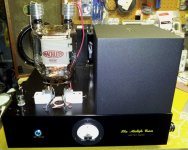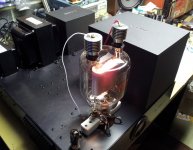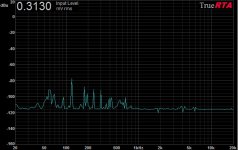Another thing: Are you running this amp on its own dedicated lighting circuit? In the US, older houses are typically wired for 15 A per circuit. 20 A in newer houses... You'll probably want to consider running a 12 AWG 20 A circuit for your amps. Just saying...
~Tom
Right now it's on a 15A circuit in my basement workshop, with a GFI outlet connected from the electrical panel.
Where it will eventually be located, in my family room, I already have a dedicated 20A line going to the stereo and two other 15 amp runs for the TV, cable, TV receiver, etc. so that should be good.
So Matthias, looking at the simulation of your supply, you are successful using an 8A fuse with a 20A peak surge, yet I'm blowing 10A fuses with a 25A peak surge. I think you have better fuses...in any case, I'm ordering some name-brand time delay ceramic bodied fuses in 10, 12 and 15A ratings, so in a few days I'll have an answer on that.
Thanks for your help!
Thanks for your help!
I started using these things now. They have a slow blow trip.
Invalid Request
As an added bonus you are no longer hunting for fuses.
Invalid Request
As an added bonus you are no longer hunting for fuses.
You could also look at the fuse data sheets. I seem to recall some of the better fuses being spec'ed with respect to their peak I2t rating. That could provide some idea for which fuses to choose.
~Tom
Agreed. I always check the data sheets...if they're available (not at Radio Shack). I ordered Littelfuse MXP series in 10, 12 and 15A sizes. The 10A is spec'ed to withstand 18.7A for 1 second before melting, the 12A is spec'ed to withstand 22.7A for 1 second before melting.
So, the startup situation is now resolved. I ended up ordering some 10W, 22R resistors (since 10W are smaller than 14W I can piggyback them) and putting two in parallel to get 11R, 20W in the soft start. With that setup, the 833 B+ now starts up fine at full current using a Littelfuse 10A slo-blo fuse.
Thanks Matthias for the simulation of the soft start, it seems to have been right on the money.
I'm starting the build on the second monoblock so I'll probably not be updating the thread for a while until I get that one complete. Then I'll be back with some impressions of the pair on my main speakers. TTYL.
P.S.: I attached a couple more pictures, a little clearer than the last.
Thanks Matthias for the simulation of the soft start, it seems to have been right on the money.
I'm starting the build on the second monoblock so I'll probably not be updating the thread for a while until I get that one complete. Then I'll be back with some impressions of the pair on my main speakers. TTYL.
P.S.: I attached a couple more pictures, a little clearer than the last.
Attachments
Beautiful job on this project, Great to be able to follow along as I won't go near 2300vdc at 200+ milliamps.
looked at 833A datasheet and the curves show it can push 4 Amps at under 400v
would more current at lower voltage achieve similar results?
Well, you can do some searches on the net and there are quite a few lower voltage, higher current 833 applications out there, even a kit available, I believe (Silvercore). The only folks I know of doing High V, lower I are myself and Ward from Monolith Magnetics (the maker of my OPTs). We're running 2000-2300V at 140-160mA. Higher voltage lets me stay in Class A1 up to ~40W, so I'm really only in A2 on peaks. Lower voltage and you'll be in A2 most/all of the time.
.
Last edited:
I think that Nobu k shishedo was running the 833 at about 1000 volts for 100 watts out; should sound better than using very high voltages. Nobu used the 805 at 800volts for about 50 watts. Then you could justify using over damped speakers like 100Db Altec 515b's and not worry about the lack of damping using 833's amps.
Phil
Phil
I think that Nobu k shishedo was running the 833 at about 1000 volts for 100 watts out; should sound better than using very high voltages. Nobu used the 805 at 800volts for about 50 watts. Then you could justify using over damped speakers like 100Db Altec 515b's and not worry about the lack of damping using 833's amps.
Phil
Why do you say lower voltages would sound better? Both George from Tubelab and Ward from Monolith have reported that the sound comes to life at higher voltages.
833 SE | Tubelab
ward's 150W single ended tube amplifier blog
.
Last edited:
I think that Nobu k shishedo was running the 833 at about 1000 volts for 100 watts out; should sound better than using very high voltages. Nobu used the 805 at 800volts for about 50 watts. Then you could justify using over damped speakers like 100Db Altec 515b's and not worry about the lack of damping using 833's amps.
Phil
Do you have a schematic for the Shishido 833? Please elaborate why it should sound better at lower plate voltage? Is this from theory or experience?
To be honest i don't know if the 833 sound better with huge voltages or lower.
Maybe it depends what speakers you use?
i have 105Db speakers; my 50 watt 805 amps would rarely go into A2.
I recently had my speakers tested; had to use a Quarter watt to test; even so had to wear ear muffs. i like these high mu tubes better than any other, but unless you use lots of feedback they have very poor damping factor, so you need to use over damped speakers.
Even with 15db feedback you would be lucky to get to to a damping factor of 4.5 my 2A3pp amp does better than this with no feedback.
phil
Maybe it depends what speakers you use?
i have 105Db speakers; my 50 watt 805 amps would rarely go into A2.
I recently had my speakers tested; had to use a Quarter watt to test; even so had to wear ear muffs. i like these high mu tubes better than any other, but unless you use lots of feedback they have very poor damping factor, so you need to use over damped speakers.
Even with 15db feedback you would be lucky to get to to a damping factor of 4.5 my 2A3pp amp does better than this with no feedback.
phil
i have 105Db speakers; my 50 watt 805 amps would rarely go into A2.
phil
The amp must be coasting most of the time with the 105dB speakers
To be honest i don't know if the 833 sound better with huge voltages or lower.
Maybe it depends what speakers you use?
i have 105Db speakers; my 50 watt 805 amps would rarely go into A2.
I recently had my speakers tested; had to use a Quarter watt to test; even so had to wear ear muffs. i like these high mu tubes better than any other, but unless you use lots of feedback they have very poor damping factor, so you need to use over damped speakers.
Even with 15db feedback you would be lucky to get to to a damping factor of 4.5 my 2A3pp amp does better than this with no feedback.
phil
I'm using a 12K:4 OPT, so the output impedance is somewhere around 1.5 ohm with zero feedback (still have to measure it). Add in a little local feedback and you can get it under 1R easily. I'm going to try zero feedback first, but I have an option to add up to 4-5dB of local feedback before my driver runs out of steam.
EDIT: PS: When I measured the OPT with a 4ohm load on the secondary, using my LCR meter, the primary was actually 13K impedance, so that's a lot of stepdown!
.
Last edited:
Thought you might be interested in the noise floor measurement for the Midlife Crisis. I measured with input shorted and a 4 ohm dummy load on the output, using my laptop with TrueRTA and a Behringer UCA-202 USB interface.
The picture below shows the noise floor while running at 150mA Ia, baseline subtracted. For some reason, TrueRTA doesn't subtract the mV readings when it does a spectrum subtraction, but the baseline (amp off) gave a level of 0.12mV, so if I subtract that from the 0.31 I get a total noise of ~.19mV. My DMM reads 0.2mV when placed on the amp outputs, so I'm pretty confident in that number.
Not bad for a one chassis amp with a 10A filament supply, a 450V driver supply, a 2300V 833 supply and a fan all in one box. I'm pleased!
As a sanity check, it is also dead quiet on 89dB speakers.
The picture below shows the noise floor while running at 150mA Ia, baseline subtracted. For some reason, TrueRTA doesn't subtract the mV readings when it does a spectrum subtraction, but the baseline (amp off) gave a level of 0.12mV, so if I subtract that from the 0.31 I get a total noise of ~.19mV. My DMM reads 0.2mV when placed on the amp outputs, so I'm pretty confident in that number.
Not bad for a one chassis amp with a 10A filament supply, a 450V driver supply, a 2300V 833 supply and a fan all in one box. I'm pleased!
As a sanity check, it is also dead quiet on 89dB speakers.
Attachments
I haven't yet implemented any shielding around the filament supply transformer or chokes (especially the first choke), which would most likely decrease the above noise even further, as the biggest peaks are at 120Hz, 180 Hz, 240 Hz, etc. Interestingly, that same series of peaks is present at approximately the same levels when I only turn on the filament and driver circuits, with the 833 B+ OFF, so I know that's where they are coming from! Since no current is flowing through the OPT in that situation (no 833 B+), I'm thinking that the noise must be picked up by the wiring from the OPT to the output jack, or maybe directly by the measurement system through the chassis. The only shielding in place is around the fan.
My concern is that shielding will compromise the cooling air flow inside the chassis, in return for benefits that are most likely inaudible. That first filament supply choke is being pushed to its limits, and the last thing I want to do is cause it to overheat by shielding insignificant noise. My inner tweaker, however, always wants to push things as far as they will go...
Thoughts?
My concern is that shielding will compromise the cooling air flow inside the chassis, in return for benefits that are most likely inaudible. That first filament supply choke is being pushed to its limits, and the last thing I want to do is cause it to overheat by shielding insignificant noise. My inner tweaker, however, always wants to push things as far as they will go...
Thoughts?
Since no current is flowing through the OPT in that situation (no 833 B+),
I found that I got a few mA of plate current with no B+ or grid voltage when the filament of the 833A was lit. 100 watts of heater power will send a few electrons streaming toward the plate. I got some audible hum in the speaker with only heater power turned on. I was using raw AC from a big transformer. Moving the heater and OPT's around on the bench did not affect the hum, but disconnecting the plate lead killed it.
- Home
- Amplifiers
- Tubes / Valves
- The Midlife Crisis - My 833C Amp Build


